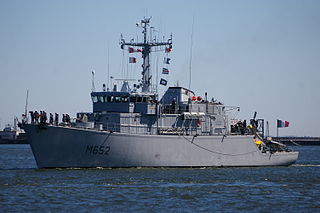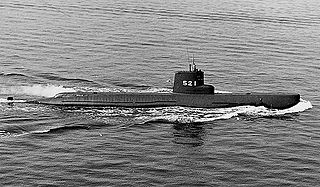
The Delfinen-class submarines were the first class of submarines constructed for the Royal Danish Navy following World War II. They were designed and built within Denmark, with first three boats of the class financed by Denmark. The fourth was financed by the United States under the Cost Share program. Constructed between 1956 and 1963, the class comprising four submarines entered service in 1961 and the last taken out of service in 1990. Replaced by the Norwegian Kobben class, three of them were scrapped while a fourth was converted into a museum ship and remains on display at the Aalborg Maritime Museum.

The Vidar-class minelayers consists of the two ships, HNoMS Vidar and HNoMS Vale built by Mjellem & Karlsen in Bergen for the Royal Norwegian Navy in 1977 and 1978. Used as multi-role ships, the Vidar class were tasked with minelaying, personnel/cargo transport, fisheries protection, torpedo-recovery ships and as anti-submarine warfare escorts in Norwegian service. In 2003, Vale was transferred to the Latvian Navy via donation and renamed Virsaitis and used as a flagship and tender to patrol craft. In 2006, Vidar was transferred to the Lithuanian Navy and renamed Jotvingis and served as flagship and tender to mine countermeasures craft. Both vessels had their ASW equipment removed upon transfer.

The Tripartite class is a class of minehunters developed from an agreement between the navies of Belgium, France and the Netherlands. A total of 35 ships were constructed for the three navies. The class was constructed in the 1980s–1990s in all three countries, using a mix of minehunting, electrical and propulsion systems from the three member nations. In France, where they are known as the Éridan class they are primarily used as minehunters, but have been used for minesweeping and ammunition transport in Belgium and the Netherlands, where the Tripartites are known as the Alkmaar class.

The Hayashio-class submarine was the successor design to the Japanese submarine Oyashio, and the predecessor of the Natsushio class with the Japan Maritime Self-Defense Force. Ordered in 1959, the boats were small with limited capability but were successful. Constructed in Japan from 1960 to 1962, they remained in service until 1979 when they were discarded.
HMCS Chaleur was a Bay-class minesweeper that served in the Royal Canadian Navy for three and a half months in 1954 before being sold to the French Navy to become La Dieppoise. The ship was named for Chaleur Bay, located between Quebec and New Brunswick. Her name was given to her replacement, Chaleur (MCB 164). As La Dieppoise, the vessel served as a coastal patrol vessel in the France's Pacific Ocean territories. The ship was taken out of service in 1987.
HMCS Miramichi was a Bay-class minesweeper that served in the Royal Canadian Navy and the French Navy. She was named Miramichi Bay, located at the mouth of the Miramichi River in New Brunswick. Entering service in 1954, the vessel served in the Royal Canadian Navy for only a few months before transferring to the French Navy. Renamed La Lorientaise, the ship was used as a minesweeper before converting to a patrol vessel in 1973. The ship was discarded in 1986.

The Sjöormen class was a class of submarines built for the Swedish Navy in the late 1960s. They had a teardrop hull shape and were capable of diving to 150 metres (490 ft). At the time of their deployment they were regarded as one of the most advanced non-nuclear submarine-classes in the world, incorporating many new features including x-rudder and anechoic tiles. Both speed and underwater endurance was at this time very high for a conventional submarine. The submarines were retired by Sweden in the early 1990s. In the late 1990s, four submarines were acquired by the Republic of Singapore Navy (RSN) and relaunched as the Challenger class following modernisation and tropicalisation.

The Poti class was the NATO reporting name for a group of anti-submarine warfare (ASW) corvettes built for the Soviet Navy. The Soviet designation was Project 204 small anti-submarine ships. These ships were the first Soviet warships powered by gas turbine engines; two propellers were mounted in tunnels to give a very shallow draught. A twin 57 mm (2 in) gun mounting provided self-defence. Three ships of the class were exported to Romania and six to Bulgaria during the Cold War. By 2008, all ships of the class were no longer extant.

The Yevgenya class, Soviet designation Project 1258 Korund, are a series of minesweepers built for the Soviet Navy and export customers between 1967 and 1980.

The Don-class submarine tender was the NATO reporting name for a group of seven submarine tenders built for the Soviet Navy in the late 1950s. The Soviet designation was Project 310 Batur. Evolving from a need for dispersed basing of submarines in the advent of a nuclear war, the ships were designed to support distant operations of the Soviet Union's submarine fleet, capable of repairing and resupplying. However, the Soviets returned to stationary basing of their submarines and the Don class were later converted into flagships. One vessel was exported to Indonesia in 1962 and due to the ship's heavy armament, was used primarily for patrol duties. The ships of the Don class were removed from service in the mid 1990s and broken up for scrap.
The October class is a series of six missile boats constructed for the Egyptian Navy in the mid-1970s as a replacement for the aging Komar-class missile boats. The design of the vessels is based on the Komar class and the six ships were constructed at Alexandria, Egypt and completed by Vosper Thornycroft at Portsmouth, United Kingdom. They entered service in the late 1970s. Two were removed from service and four are still active.
HMCS Thunder was a Bay-class minesweeper that served in the Royal Canadian Navy during the Cold War. The ship was named for Thunder Bay. This was the third vessel to carry the name and the second in the class, replacing a previous vessel sold to France. The minesweeper entered service in 1957 and was paid off in 1997.
HMCS Thunder was a Bay-class minesweeper that served in the Royal Canadian Navy for three and a half months in 1954 before being sold to the French Navy to become La Paimpolaise. The ship was named for Thunder Bay and was the second vessel to carry the name. Her name was given to her replacement, HMCS Thunder (MCB 161).
HMCS Chaleur was a Bay-class minesweeper that served in the Royal Canadian Navy during the Cold War. Entering service in 1957, the minesweeper was used mainly as a training ship on the West Coast of Canada. The vessel was discarded in 1998 and broken up in 1999.
HMCS Chignecto was a Bay-class minesweeper that served in the Royal Canadian Navy during the Cold War. The ship entered service in 1953 and in 1954, was transferred to the French Navy and renamed La Bayonnaise. Serving as a minesweeper until 1973, the ship became a territorial patrol ship and remained in service until 1976. La Bayonnaise was broken up for scrap in 1977.
HMCS Cowichan was a Bay-class minesweeper that served in the Royal Canadian Navy during the Cold War. The minesweeper entered service in 1953 and was transferred to the French Navy in 1954. Renamed La Malouine, the ship was converted to a territorial patrol vessel in 1973 and remained in service until 1977. La Malouine was sunk as a target ship in 1985.
HMCS Cowichan was a Bay-class minesweeper that served in the Royal Canadian Navy during the Cold War. Entering service in 1957, the minesweeper was used primarily as a training vessel on the Pacific coast of Canada. Decommissioned in 1997, the ship was sold in 1999 for conversion to a yacht.
HMCS Fundy was a Bay-class minesweeper that was constructed for the Royal Canadian Navy during the Cold War. The minesweeper entered service in March 1954 and was transferred later that month to the French Navy. Renamed La Dunkerquoise, the ship was converted to a territorial patrol vessel in 1973 and remained in service until 1984. La Dunkerquoise was discarded in 1986.
HMCS Fundy was a Bay-class minesweeper that was constructed for the Royal Canadian Navy during the Cold War. Entering service in 1956, the vessel was used as a training ship on the West Coast of Canada for the majority of her career. Fundy was decommissioned in 1996 and the fate of the vessel is unknown.

HMCS Miramichi was a Bay-class minesweeper that was constructed for the Royal Canadian Navy during the Cold War. Entering service in 1957, the vessel was used as a training ship on the West Coast of Canada for the majority of her career. Miramichi was decommissioned in 1998 and the vessel's fate is unknown.








